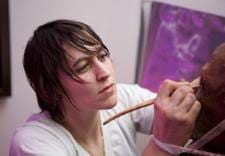“Wouldn’t it be cool if…”
That’s the whimsical and childlike thought that sparks all of Cara Tierney’s creative projects.
Tierney is a performance artist. Ask her what she does and she’ll hardly know where to start. Though she works at the National Gallery of Canada and teaches at Algonquin Collage, Tierney refers to herself as a guerrilla performance artist — one who performs pieces which carry deep social meaning anywhere and for anyone.
Tierney is considered by many to be a gender activist — and a passionate one at that.
A quick glance at her work makes the reasoning obvious. In one performance, entitled How the Tiger Got Her Stripes, Tierney confronts the gender-binary bathroom issue where she tries to enter a mock bathroom through human-sized cut-outs of male and female washroom signs while dressed in wooden rainbow stripes. Her unsuccessful effort to fit through either door results in an angry demolishing of the signs and the bathroom Itself.
In a performance piece from 2007, she took over someone’s bathroom for two hours to get ready for a non-existent prom — leaving the door open to viewers as she showered, shaved, got dressed and put on make-up. Once dressed and ready, she proceeded to cover her entire body in liquid foundation. Perhaps symbolic of the masking of self that often takes place in the performance of gender?
That’s just two example of the many performances that Tierney has created in an effort to speak to some of the social issues that gnaw away at the queer community, and our society in general.
But Tierney says she does not start out with a concept or a burning issue. She starts, quite simply, with herself — her personal experiences, pains, confusions and uncertainties.
“I don’t start with activism, I start with my life. It’s the only thing I can be truly 100% confident about. Even if the only thing I’m confident about is my lack of confidence! These are woman issues, gender issues, queer issues — yes. But at some base level I’m reacting because it’s something I’m the owner of.”
Using her own body as a point of departure, Tierney speaks to the construction of femininity in our society and the heterocentrist coding of meaning in North America. In doing so, her work identifies issues of inclusivity and exclusivity, uncertainty and certainty, fear and honesty and the rituals upon which we hang our identities.
Tierney believes that performance art is one of the most powerful media to address these kinds of issues.
“Performance art is so accessible to everybody. I feel it’s the most democratic art. It’s more powerful than a gallery wall. In performance art I am there with the audience, and I am directly responsible for their experience. Afterwards the audience may not remember your name, but they’ll remember the impact of that performance.”
It’s that shared experience and the dialogues she is able to spark as a result that fuel Tierney’s passion for performing on gender and sexuality.
“Having a conversation is harder for me than performing. I’ve always been very visually and musically expressive. Sometimes it’s easier to create artwork than speak. And then the art creates this awesome experience. And you end up having all these “me too,” conversations.”
Performing at Westfest this year, Tierney will be speaking to a large audience, possibly hundreds. She has carefully tailored a performance to be inclusive of the diverse group.
“The Westfest performance is definitely a “wouldn’t it be cool if…” creation. It will be a large, group game — essentially a collective experience in play. There’ll be themes of community, sharing and participating…but mostly it’s just going to be really fun. At heart I’m just a really big kid. And I feel that as adults, we just don’t play enough.”

 Why you can trust Xtra
Why you can trust Xtra


